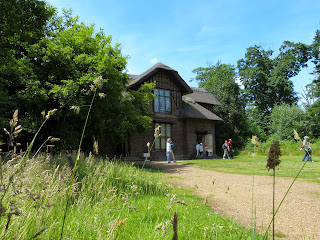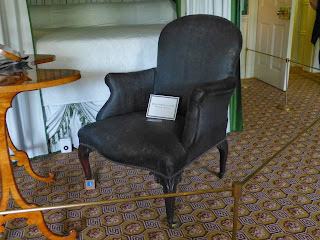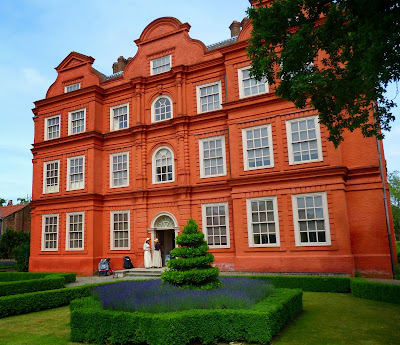Kew Palace is situated within the botanical gardens at Kew in London.
History
Kew Palace was built for a rich merchant in the 1630s with its distinctive curved gables on each façade and characteristic red colour. It is sometimes referred to as the Red House or the Dutch House. It was first used as a royal residence in 1729 by George II and Queen Caroline as a home for their eldest daughters.
History
Kew Palace was built for a rich merchant in the 1630s with its distinctive curved gables on each façade and characteristic red colour. It is sometimes referred to as the Red House or the Dutch House. It was first used as a royal residence in 1729 by George II and Queen Caroline as a home for their eldest daughters.
 |
| Kew Palace - rear view (2013) |
Georgian connection
Early Georgian
From 1728, George II’s eldest daughters, Anne, Caroline and Amelia, lived in Kew Palace whilst Frederick, Prince of Wales, lived in the White House, a larger building which used to stand opposite.
After his estrangement from his father, Frederick lived at Kew with his wife, Princess Augusta, and his growing family. Princess Augusta was a keen botanist and promoted the development of Kew Gardens. She also kept a menagerie of animals.
George III had lessons with his brother Edward in Kew Palace. When his father died in 1751, Princess Augusta managed to persuade the King to allow her shy 13 year old son to stay with her at Kew.
George III had lessons with his brother Edward in Kew Palace. When his father died in 1751, Princess Augusta managed to persuade the King to allow her shy 13 year old son to stay with her at Kew.
In 1764, George III’s eldest sons, George (later George IV) and Frederick (later Duke of York), were quarantined with whooping cough in Kew Palace.
After this, George III and Queen Charlotte began to use Kew as additional accommodation for their ever increasing family and after the death of George III’s mother, Princess Augusta, in 1772, they began to use the White House as their country retreat rather than Richmond Lodge. George and Frederick had their own establishment in Kew Palace.
At Kew, George III and Queen Charlotte led a more normal family life. They played cricket, celebrated birthdays and had picnics at Queen Charlotte’s Cottage in the gardens, with the Queen’s menagerie nearby.
After this, George III and Queen Charlotte began to use Kew as additional accommodation for their ever increasing family and after the death of George III’s mother, Princess Augusta, in 1772, they began to use the White House as their country retreat rather than Richmond Lodge. George and Frederick had their own establishment in Kew Palace.
At Kew, George III and Queen Charlotte led a more normal family life. They played cricket, celebrated birthdays and had picnics at Queen Charlotte’s Cottage in the gardens, with the Queen’s menagerie nearby.
 |
| Queen Charlotte's Cottage (2013) |
From 1776, George III spent more time at Windsor and visited Kew less frequently, although the royal nursery remained at Kew.
George III’s illness
When George III became mentally unstable in 1788, he was confined in apartments in the White House at Kew and again in 1801 while the Queen and Princesses stayed in Kew Palace. On a further recurrence of his illness in 1804, he was confined in Kew Palace itself.
Around 1800, George III planned to build a Gothic castellated palace at Kew, but it was never completed. He visited Kew for the last time in 1806 and work on the new palace was abandoned.
Around 1800, George III planned to build a Gothic castellated palace at Kew, but it was never completed. He visited Kew for the last time in 1806 and work on the new palace was abandoned.
 |
| Queen Charlotte's bedroom, Kew Palace (2013) |
In June 1818 Queen Charlotte became ill on her way to Windsor and was forced to stay at Kew. She became too ill to move and so the double wedding of Edward, Duke of Kent, and Princess Victoria of Saxe-Coburg-Leiningen, and William, Duke of Clarence, and Princess Adelaide of Saxe-Meiningen, was conducted in the Queen’s drawing room at Kew Palace on 11 July 1818.
Queen Charlotte died in Kew Palace on 17 November 1818.
Queen Charlotte died in Kew Palace on 17 November 1818.
What can you see today?
• A wax head of George III made by Madame Tussaud from life
 |
| Wax head of George III made by Madame Tussaud (2013) |
 |
| The chair that Queen Charlotte reportedly died in (2013) |
 |
| George III's harpsichord in the Queen's drawing room at Kew Palace (2013) |
 |
| George III’s bath (2013) |
 |
| The hatchment displayed at the palace after Queen Charlotte’s death (2013) |
 |
| Costumed guides Alice Painting and Mary Ruane at the front entrance to Kew Palace (June 2013) |
Last visited: June 2013.
If you enjoyed this article, you might also enjoy my guide to Kensington Palace.
If you enjoyed this article, you might also enjoy my guide to Kensington Palace.
To discover more about Kew, read my guides to Queen Charlotte's Cottage and the White House.
Rachel Knowles writes clean/Christian Regency era romance and historical non-fiction. She has been sharing her research on this blog since 2011. Rachel lives in the beautiful Georgian seaside town of Weymouth, Dorset, on the south coast of England, with her husband, Andrew.
Find out more about Rachel's books and sign up for her newsletter here.If you have enjoyed this blog and want to encourage me and help me to keep making my research freely available, please buy me a virtual cup of coffee by clicking the button below.
Sources used include:
Groom, Susanne and Prosser, Lee, Kew Palace, the official illustrated history (2006)
Groom, Susanne and Prosser, Lee, Kew Palace, the official illustrated history (2006)
Photographs © RegencyHistory.net




Really interesting. Kew wasn't on my radar but now it certainly is and can't wait to visit.
ReplyDeleteGrace x
It's a great place to visit and the gardens are lovely too. It reopens on 29 Mar 2014 for the summer season but you need to visit at a weekend or Bank Holiday if you want to see inside Queen Charlotte's cottage. Single entry fee now to see gardens and palace. Enjoy :)
Delete